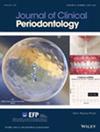Validation of the Diabetes Risk Assessment in Dentistry Score in NHANES 2009-2014.
IF 6.8
1区 医学
Q1 DENTISTRY, ORAL SURGERY & MEDICINE
引用次数: 0
Abstract
AIM To validate the Diabetes Risk Assessment in Dentistry Score (DDS) in a US population-based sample and compare its performance with the American Diabetes Association (ADA) risk calculator and the Leicester Risk Assessment (LRA). METHODS Data were obtained from the National Health and Nutrition Examination Survey (NHANES) covering the 2009-2014 cycles. The study focused on participants aged 40 years and older who included complete data for DDS and ADA risk score assessment. Model performance was evaluated using the area under the receiver operating characteristic curve (AUC), while decision curve analysis (DCA) was used to evaluate the clinical utility of the model. RESULTS Of the 6259 participants included, the average age was 57.3 years (±12.0 years, range: 40-80 years) and the sample was evenly distributed by sex (50.8% female). DDS showed limited discriminative ability with an AUC of 0.64 (95% confidence interval [CI]: 0.62-0.65), and DCA analysis showed higher net benefit than the 'Treat None' strategy across most probability thresholds, indicating added clinical value in decision making. The ADA risk calculator and LRA showed an AUC of 0.61 (95% CI: 0.59-0.63) and 0.631 (95% CI: 0.615-0.647), which were below the DDS performance. CONCLUSION The DDS demonstrated acceptable performance for American adults aged 40 years or older, and showed marginally superior performance compared with the ADA diabetes risk calculator and LRA, highlighting its potential utility in dental practice settings as a complementary screening tool.NHANES 2009-2014中牙科糖尿病风险评估评分的验证
目的在美国人群为基础的样本中验证牙科糖尿病风险评估评分(DDS),并将其与美国糖尿病协会(ADA)风险计算器和莱斯特风险评估(LRA)进行比较。方法数据来源于2009-2014周期的国家健康与营养检查调查(NHANES)。该研究的重点是40岁及以上的参与者,他们包括DDS和ADA风险评分评估的完整数据。采用受试者工作特征曲线下面积(AUC)评价模型性能,采用决策曲线分析(DCA)评价模型的临床实用性。结果6259人平均年龄57.3岁(±12.0岁,40 ~ 80岁),性别分布均匀,女性占50.8%。DDS显示出有限的判别能力,AUC为0.64(95%可信区间[CI]: 0.62-0.65), DCA分析显示,在大多数概率阈值上,DCA策略的净收益高于“不治疗”策略,表明在决策中增加了临床价值。ADA风险计算器和LRA的AUC分别为0.61 (95% CI: 0.59-0.63)和0.631 (95% CI: 0.615-0.647),均低于DDS的表现。结论DDS在40岁及以上的美国成年人中表现良好,与ADA糖尿病风险计算器和LRA相比表现略好,突出了其作为牙科诊所辅助筛查工具的潜在效用。
本文章由计算机程序翻译,如有差异,请以英文原文为准。
求助全文
约1分钟内获得全文
求助全文
来源期刊

Journal of Clinical Periodontology
医学-牙科与口腔外科
CiteScore
13.30
自引率
10.40%
发文量
175
审稿时长
3-8 weeks
期刊介绍:
Journal of Clinical Periodontology was founded by the British, Dutch, French, German, Scandinavian, and Swiss Societies of Periodontology.
The aim of the Journal of Clinical Periodontology is to provide the platform for exchange of scientific and clinical progress in the field of Periodontology and allied disciplines, and to do so at the highest possible level. The Journal also aims to facilitate the application of new scientific knowledge to the daily practice of the concerned disciplines and addresses both practicing clinicians and academics. The Journal is the official publication of the European Federation of Periodontology but wishes to retain its international scope.
The Journal publishes original contributions of high scientific merit in the fields of periodontology and implant dentistry. Its scope encompasses the physiology and pathology of the periodontium, the tissue integration of dental implants, the biology and the modulation of periodontal and alveolar bone healing and regeneration, diagnosis, epidemiology, prevention and therapy of periodontal disease, the clinical aspects of tooth replacement with dental implants, and the comprehensive rehabilitation of the periodontal patient. Review articles by experts on new developments in basic and applied periodontal science and associated dental disciplines, advances in periodontal or implant techniques and procedures, and case reports which illustrate important new information are also welcome.
 求助内容:
求助内容: 应助结果提醒方式:
应助结果提醒方式:


